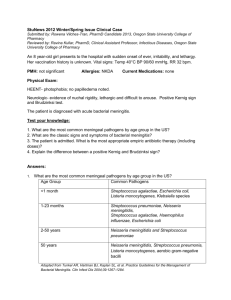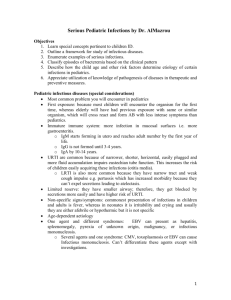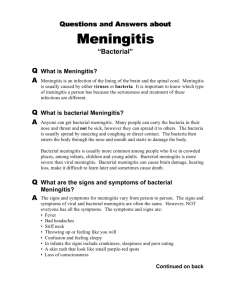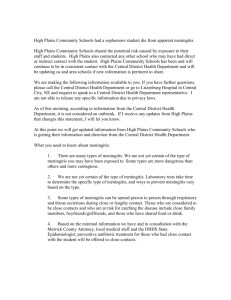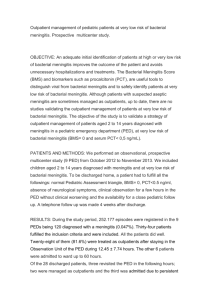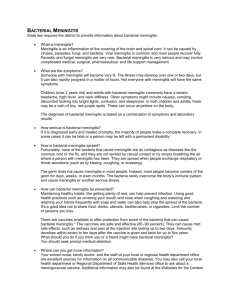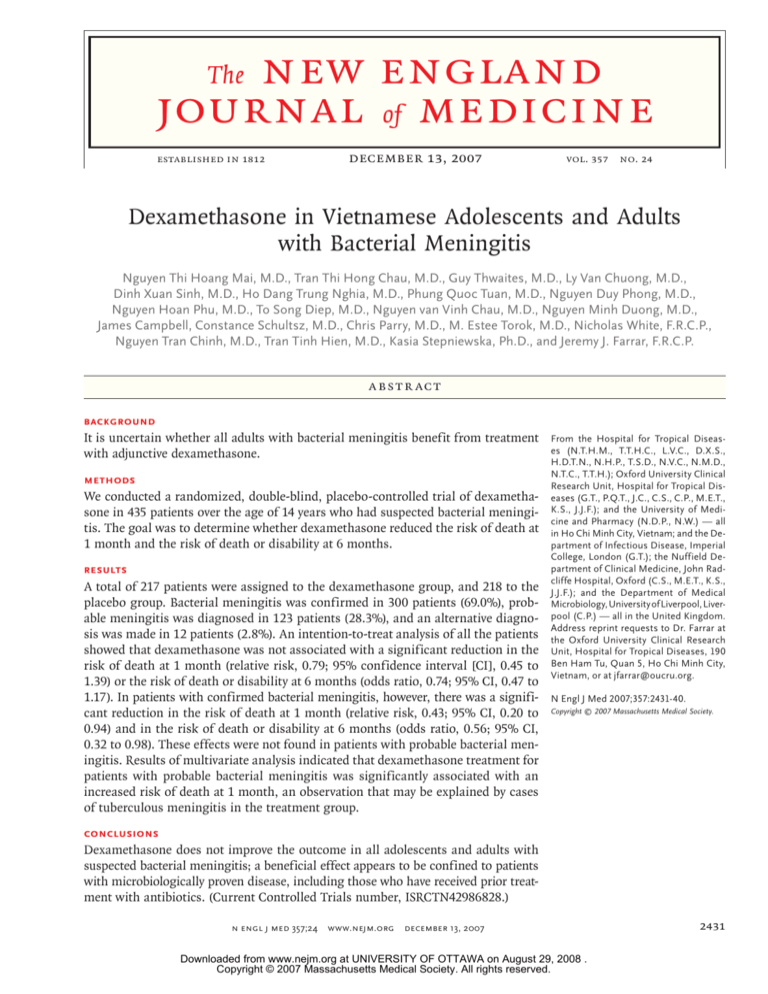
new england
journal of medicine
The
established in 1812
december 13, 2007
vol. 357 no. 24
Dexamethasone in Vietnamese Adolescents and Adults
with Bacterial Meningitis
Nguyen Thi Hoang Mai, M.D., Tran Thi Hong Chau, M.D., Guy Thwaites, M.D., Ly Van Chuong, M.D.,
Dinh Xuan Sinh, M.D., Ho Dang Trung Nghia, M.D., Phung Quoc Tuan, M.D., Nguyen Duy Phong, M.D.,
Nguyen Hoan Phu, M.D., To Song Diep, M.D., Nguyen van Vinh Chau, M.D., Nguyen Minh Duong, M.D.,
James Campbell, Constance Schultsz, M.D., Chris Parry, M.D., M. Estee Torok, M.D., Nicholas White, F.R.C.P.,
Nguyen Tran Chinh, M.D., Tran Tinh Hien, M.D., Kasia Stepniewska, Ph.D., and Jeremy J. Farrar, F.R.C.P.
A bs t r ac t
Background
It is uncertain whether all adults with bacterial meningitis benefit from treatment
with adjunctive dexamethasone.
Methods
We conducted a randomized, double-blind, placebo-controlled trial of dexamethasone in 435 patients over the age of 14 years who had suspected bacterial meningitis. The goal was to determine whether dexamethasone reduced the risk of death at
1 month and the risk of death or disability at 6 months.
Results
A total of 217 patients were assigned to the dexamethasone group, and 218 to the
placebo group. Bacterial meningitis was confirmed in 300 patients (69.0%), probable meningitis was diagnosed in 123 patients (28.3%), and an alternative diagnosis was made in 12 patients (2.8%). An intention-to-treat analysis of all the patients
showed that dexamethasone was not associated with a significant reduction in the
risk of death at 1 month (relative risk, 0.79; 95% confidence interval [CI], 0.45 to
1.39) or the risk of death or disability at 6 months (odds ratio, 0.74; 95% CI, 0.47 to
1.17). In patients with confirmed bacterial meningitis, however, there was a significant reduction in the risk of death at 1 month (relative risk, 0.43; 95% CI, 0.20 to
0.94) and in the risk of death or disability at 6 months (odds ratio, 0.56; 95% CI,
0.32 to 0.98). These effects were not found in patients with probable bacterial meningitis. Results of multivariate analysis indicated that dexamethasone treatment for
patients with probable bacterial meningitis was significantly associated with an
increased risk of death at 1 month, an observation that may be explained by cases
of tuberculous meningitis in the treatment group.
From the Hospital for Tropical Diseases (N.T.H.M., T.T.H.C., L.V.C., D.X.S.,
H.D.T.N., N.H.P., T.S.D., N.V.C., N.M.D.,
N.T.C., T.T.H.); Oxford University Clinical
Research Unit, Hospital for Tropical Diseases (G.T., P.Q.T., J.C., C.S., C.P., M.E.T.,
K.S., J.J.F.); and the University of Medicine and Pharmacy (N.D.P., N.W.) — all
in Ho Chi Minh City, Vietnam; and the Department of Infectious Disease, Imperial
College, London (G.T.); the Nuffield Department of Clinical Medicine, John Radcliffe Hospital, Oxford (C.S., M.E.T., K.S.,
J.J.F.); and the Department of Medical
Microbiology, University of Liverpool, Liver­
pool (C.P.) — all in the United Kingdom.
Address reprint requests to Dr. Farrar at
the Oxford University Clinical Research
Unit, Hospital for Tropical Diseases, 190
Ben Ham Tu, Quan 5, Ho Chi Minh City,
Vietnam, or at jfarrar@oucru.org.
N Engl J Med 2007;357:2431-40.
Copyright © 2007 Massachusetts Medical Society.
Conclusions
Dexamethasone does not improve the outcome in all adolescents and adults with
suspected bacterial meningitis; a beneficial effect appears to be confined to patients
with microbiologically proven disease, including those who have received prior treatment with antibiotics. (Current Controlled Trials number, ISRCTN42986828.)
n engl j med 357;24 www.nejm.org december 13, 2007
Downloaded from www.nejm.org at UNIVERSITY OF OTTAWA on August 29, 2008 .
Copyright © 2007 Massachusetts Medical Society. All rights reserved.
2431
The
n e w e ng l a n d j o u r na l
P
yogenic bacterial meningitis has
neurologic sequelae or is fatal in 30% of affected patients.1 Animal models of the disease suggest that the subarachnoid inflammatory
response contributes to morbidity and mortality2,3
and that corticosteroids may improve the outcome
by attenuating this response. However, confirming this effect in humans has proved difficult.4
We conducted a double-blind, placebo-controlled
trial in Vietnam to determine whether adjunctive
dexamethasone improves the outcome in adolescents and adults with bacterial meningitis.
A meta-analysis of randomized, controlled trials of corticosteroids for bacterial meningitis that
were reported between 1966 and 2001 concluded
that corticosteroids reduced the rates of death,
neurologic sequelae, and hearing loss in children,
but there were too few data on adults to confirm
an effect.5 In 2002, two studies with conflicting
results were published. The first, involving 598
Malawian children,6 showed that dexamethasone
had no effect on the rates of death or neurologic sequelae. The second, involving 300 European adults, showed that fewer patients in the
dexamethasone group died or were disabled as
compared with the placebo group.7 A subsequent
meta-analysis of five trials involving 632 adults
showed that the use of adjunctive corticosteroids
was associated with a reduction in the rates of
death and sequelae, but the results were heavily
influenced by the European trial, making it difficult to derive treatment recommendations for
patients in different settings.8
Me thods
Study Setting and Participants
We recruited study participants from the Hospital for Tropical Diseases in Ho Chi Minh City,
Vietnam. Patients older than 14 years with suspected bacterial meningitis were eligible to enter
the study. Inclusion criteria were clinical evidence
of meningitis (defined as nuchal rigidity, with ele­
vations in the white-cell count and protein concentration in the cerebrospinal fluid) and at least
one of the following: bacteria detected in cerebrospinal fluid by Gram’s or acridine orange stain;
a positive cerebrospinal fluid latex agglutination
test (Wellcogen, Remel Europe); pathogenic bacteria cultured from either the blood or the cerebrospinal fluid; or a clinical history of less than
7 days of illness, with a cloudy cerebrospinal fluid,
a white-cell count with more than 60% neutro2432
of
m e dic i n e
phils, and a ratio of cerebrospinal fluid to blood
glucose that was less than 50%. Patients were
excluded from the study if they were in the first
trimester of pregnancy, there was evidence of active pulmonary tuberculosis, the attending physician believed corticosteroids were contraindicated, or consent from either the patient or a family
member was not obtained. Prior treatment with
antibiotics was not a criterion for exclusion.
At the time of discharge from the hospital or
death, patients were classified as having definite
bacterial meningitis if bacteria were detected in
the cerebrospinal fluid or cultured from the cerebrospinal fluid or blood. They were classified as
having probable meningitis if bacteria were neither detected nor cultured, but there was no alternative diagnosis.
The ethics committee of the Hospital for
Tropical Diseases approved the study protocol.
Oral informed consent to participate in the study
was obtained from all patients or their relatives.
Laboratory Studies
Lumbar punctures were performed at presentation. Cerebrospinal fluid specimens were stained
and cultured for bacteria with the use of standard methods. Drug-susceptibility tests were performed by means of standard methods, and resistance was confirmed with the Etest (AB-Biodisk).
All patients were tested for antibodies to the human immunodeficiency virus (or HIV).
Treatment
Patients were randomly assigned to receive intravenous dexamethasone sodium phosphate, 0.4 mg
per kilogram of body weight, every 12 hours for
4 days, or placebo. The study medication was
given 15 minutes before the administration of
antibiotics, although some patients may have had
prior antibiotic treatment. A computer-generated
sequence of random numbers was used to assign
treatment in blocks of 100 patients. If a patient
met the entry criteria, the attending physician instructed a nurse to open a numbered envelope
containing instructions to give either active drug
or placebo. To maintain blinding, a separate team
of nurses, who were not otherwise involved in
the care of the study patients, opened the envelopes and gave the injections. All patients, the
physicians who enrolled them, and study investigators were unaware of the treatment assignments
until the last patient had completed follow-up.
All patients were treated with ceftriaxone (2 g
n engl j med 357;24 www.nejm.org december 13, 2007
Downloaded from www.nejm.org at UNIVERSITY OF OTTAWA on August 29, 2008 .
Copyright © 2007 Massachusetts Medical Society. All rights reserved.
Dexamethasone for Bacterial Meningitis
given intravenously every 12 hours) for 10 to 14
days. Antibiotic treatment could be altered at the
discretion of the attending physician. The attending physicians were responsible for enrolling the
patients and recording the clinical data in individual study notes.
Outcome Assessment
The primary outcome was death 1 month after
randomization. Secondary outcomes were death
at 6 months, disability at 1 and 6 months, and
hearing loss at 1 and 6 months. Disability was
assessed with the use of the modified Rankin
scale, on which a score of 0 indicates no symptoms; 1, minor symptoms not interfering with
lifestyle; 2, symptoms that may restrict lifestyle
but do not impede independent living; 3, symptoms that restrict lifestyle and interfere with independent living; 4, symptoms that clearly prevent
independent living, although constant care and
attention are not required; and 5, symptoms that
result in complete dependence on others, requiring constant help day and night. Classification of
the outcome as full recovery (a Rankin score of
0), mild sequelae (a score of 1 or 2), and severe
disability (a score of 3, 4, or 5) was defined before the start of the trial. Hearing was assessed
by means of audiometry. Deafness was defined as
failure to register sounds of 80 dB or less.
or >50 years), prior antibiotic treatment (yes or
no), and the major pathogen group (gram-positive or gram-negative bacteria, Streptococcus suis, or
S. pneumoniae). A multivariate Cox regression model, with a forward variable-selection procedure,
was constructed to identify independent predictors of death during the first month.
Analysis of secondary outcomes, comparing
death or severe disability, hearing loss, and adverse events after 6 months, was performed with
the chi-square test, with odds ratios calculated
by means of logistic regression. The last record­
ed disability score was obtained as the 6-month
score for patients who did not complete followup. All analyses were performed with SPSS (Micro­
soft) and Stata (StataCorp) software. All reported
P values are two-sided.
The data monitoring and safety committee
reviewed the results of the study after the first
50 patients had been enrolled. The predefined
criterion for stopping the trial early was a difference of more than 3 SD between the proportions
450 Patients were screened
15 Did not provide consent
or were excluded
435 Were enrolled
Statistical Analysis
The mortality from microbiologically confirmed
bacterial meningitis among adults at the hospital
before the study (when corticosteroids were not ad­
ministered) was 25%. We calculated that 150 patients with definite bacterial meningitis would be
required in each treatment group to provide at least
80% power to detect a reduction in mortality from
25% to 12.5%, with a significance level of 0.05.
Data analysis followed a prespecified plan unless otherwise stated. Kaplan–Meier estimates of
survival in the two study groups were compared
with the use of the log-rank test. Data on patients
who were lost to follow-up were censored at the
time of the last recorded outcome. The relative
risk of death between the treatment groups was
calculated by means of Cox regression. A test of
interaction with treatment was used to examine
heterogeneity in treatment effect among subgroups of patients. Prespecified subgroup analysis compared the primary outcomes in participants
grouped according to the diagnosis (definite vs.
probable bacterial meningitis), sex, age (≤50 years
217 Were randomly assigned
to receive dexamethasone;
all received the drug
218 Were randomly assigned
to receive placebo; all
received placebo
2 Were lost to follow-up after 1 mo
(both were transferred to the
tuberculosis hospital for treatment of tuberculous meningitis)
1 Discontinued dexamethasone
because of gastrointestinal
bleeding
4 Were lost to follow-up after 1 mo
1 Was transferred to the ear,
nose, and throat hospital for
surgical treatment of mastoiditis
3 Were transferred to the tuberculosis hospital for treatment
of tuberculous meningitis
0 Discontinued placebo
217 Were included in the analysis
218 Were included in the analysis
Figure 1. Enrollment and Outcomes.
ICM
AUTHOR: Mai (Farrar)
RETAKE
FIGURE: 1 of 2
n engl j med 357;24 www.nejm.org december 13, 2007
REG F
CASE
EMail
ARTIST: ts
Line
4-C
H/T
Downloaded from www.nejm.org at UNIVERSITY OF Enon
OTTAWA on August 29,
2008 .H/T
Copyright © 2007 Massachusetts Medical Society. All rights reserved.Combo
AUTHOR, PLEASE NOTE:
Revised
SIZE
22p3
1st
2nd
3rd
2433
The
n e w e ng l a n d j o u r na l
of
m e dic i n e
of patients who died in the two groups; the trial ceived dexamethasone and 157 received placebo.
was not stopped early.
Probable meningitis was diagnosed in 123 patients
(28.3%), and an alternative diagnosis was made
in 12 patients (2.8%) (Table 1). Mycobacterium tuberR e sult s
culosis was isolated from a cerebrospinal fluid culCharacteristics of the Patients
ture in nine patients (four received dexamethaBetween November 1996 and June 2005, a total sone, and five placebo), and Cryptococcus neoformans
of 435 patients were randomly assigned to receive was isolated from one patient, who was given
dexamethasone (217 patients) or placebo (218) dexamethasone. Eosinophilic meningitis was diag­
(Fig. 1). Definite bacterial meningitis was con- nosed in two patients, both given placebo, on the
firmed in 300 patients (69.0%), of whom 143 re- basis of high proportions of eosinophils (>30%)
Table 1. Baseline Characteristics of the Patients.*
Characteristic
Dexamethasone
Placebo
Age
No. of patients
217
Median — yr
42
41
Range — yr
15–89
15–91
165/217 (76.0)
152/218 (69.7)
No. of patients
217
218
Median — days
4
3
Male sex — no./total no. (%)
218
Duration of illness
Range — days
Prior antibiotic therapy — no./total no. (%)
1–30
1–21
139/217 (64.1)
128/218 (58.7)
217
218
Glasgow Coma Scale score†
No. of patients
Median
13
13
Range
3–15
3–15
Rash — no./total no. (%)
23/213 (10.8)
19/215 (8.8)
Cranial-nerve palsy — no./total no. (%)
16/209 (7.7)
19/213 (8.9)
Hemiparesis — no./total no. (%)
23/201 (11.4)
13/200 (6.5)
211
211
Peripheral-blood white-cell count
No. of patients
Median — per
mm3
Range — per mm3
Pathogen cultured from blood — no./total no. (%)
HIV infection — no./total no. (%)
16,000
17,200
3600–80,000
2100–57,000
66/217 (30.4)
62/218 (28.4)
2/215 (0.9)
1/215 (0.5)
168
177
CSF opening pressure
No. of patients
Median — cm
20
20
Range — cm
0–55
0–41
CSF total white-cell count
2434
No. of patients
216
217
Median — per mm3
2970
2800
Range — per mm3
1–30,000
35–64,000
n engl j med 357;24 www.nejm.org december 13, 2007
Downloaded from www.nejm.org at UNIVERSITY OF OTTAWA on August 29, 2008 .
Copyright © 2007 Massachusetts Medical Society. All rights reserved.
Dexamethasone for Bacterial Meningitis
Table 1. (Continued.)
Characteristic
Dexamethasone
Placebo
CSF total protein
No. of patients
214
210
Median — mg/dl
229
236
Range — mg/dl
20–1518
30–1460
Ratio of CSF glucose to plasma glucose
No. of patients
213
218
Median
0.19
0.19
Range
0.004–0.71
0.001–0.68
Diagnosis — no./total no. (%)
Definite bacterial meningitis
143/217 (65.9)
157/218 (72.0)
Probable bacterial meningitis
69/217 (31.8)
54/218 (24.8)
Other (not bacterial meningitis)‡
Pathogen cultured from CSF — no./total no. (%)
5/217 (2.3)
108/216 (50.0)
7/218 (3.2)
114/218 (52.3)
Streptococcus suis
60/216 (27.7)
56/218 (25.7)
S. pneumoniae
26/216 (12.0)
29/218 (13.3)
Streptococcus species§
6/216 (2.8)
12/218 (5.5)
Staphylococcus aureus
3/216 (1.4)
6/218 (2.8)
Coagulase-negative staphylococcus
0
1/218 (0.5)
Neisseria meningitidis
9/216 (4.1)
10/218 (4.6)
Haemophilus influenzae
1/216 (0.5)
6/218 (2.8)
Klebsiella species
7/216 (3.2)
3/218 (1.4)
Escherichia coli
6/216 (2.8)
3/218 (1.4)
Other gram-negative bacteria¶
2/216 (0.9)
2/218 (0.9)
Acridine orange stain only
11/217 (5.1)
13/218 (6.0)
Gram’s stain or acridine orange stain‖
12/217 (5.5)
16/218 (7.3)
Bacteria seen in CSF but not cultured — no./total no. (%)
*There were no significant differences in the baseline characteristics between the study groups. CSF denotes cerebrospinal fluid.
†Scores on the Glasgow Coma Scale range from 3 (deep coma) to 15 (normal neurologic status).
‡In the dexamethasone group, one patient had cryptococcal meningitis and four had tuberculous meningitis. In the placebo group, five patients had tuberculous meningitis and two had parasitic eosinophilic meningitis.
§ In the dexamethasone group, three patients were infected with S. intermedius, one with S. bovis, and two with nonLancefield grouping α-hemolytic streptococci. In the placebo group, one patient was infected with S. intermedius, two
with S. bovis, seven with non-Lancefield grouping, optochin-resistant, α-hemolytic streptococci, and two with S. agalactiae.
¶In the dexamethasone group, one patient was infected with Pseudomonas aeruginosa, and one with bacteroides species.
In the placebo group, one patient was infected with Proteus mirabilis, and one with bacteroides species.
‖In the dexamethasone group, nine patients were infected with gram-positive cocci and three with gram-negative bacilli.
In the placebo group, 11 patients were infected with gram-positive cocci and 5 with gram-negative bacilli.
in the cerebrospinal fluid. Two patients in the
dexamethasone group and four in the placebo
group were lost to follow-up 1 month after randomization (Fig. 1).
The baseline clinical characteristics of the
patients were similar in the two study groups
(Table 1). S. suis caused the highest proportion
of cases (a total of 116, of which 115 were serotype 2), followed by S. pneumoniae (55 cases). Of
the 3 patients with Staphylococcus aureus meningitis
(2 receiving dexamethasone, and 1 placebo), 2 pa­
tients also received oxacillin and 1 patient (with
a methicillin-resistant isolate) received vancomycin. Forty patients (19 receiving dexamethasone,
n engl j med 357;24 www.nejm.org december 13, 2007
Downloaded from www.nejm.org at UNIVERSITY OF OTTAWA on August 29, 2008 .
Copyright © 2007 Massachusetts Medical Society. All rights reserved.
2435
The
n e w e ng l a n d j o u r na l
1.00
Proportion Surviving
Dexamethasone
P=0.42
0.90
Placebo
0.85
0.80
0.75
0.00
0
5
10
15
20
25
30
200
192
199
192
Days since Randomization
No. at Risk
Dexamethasone 217
Placebo
218
210
204
208
200
202
196
201
196
B Definite Bacterial Meningitis
1.00
Dexamethasone
Proportion Surviving
0.95
0.90
P=0.03
Placebo
0.85
m e dic i n e
Figure 2. Kaplan–Meier Survival Estimates According to
Study Group.
Panel A shows survival estimates for all patients who
underwent randomization (intention-to-treat analysis).
Panel B shows survival estimates for patients with definite bacterial meningitis, and Panel C estimates for
patients with probable bacterial meningitis. P values
are based on the log-rank test.
A All Patients
0.95
of
0.80
and 21 placebo) were treated with a combination of ceftriaxone and vancomycin, and 26 patients (11 receiving dexamethasone, and 15 placebo) with a combination of ceftriaxone and
rifampin. Of 55 S. pneumoniae isolates, 50 (90.9%)
were susceptible to ceftriaxone (minimal inhibitory concentration [MIC], ≤0.5 μg per milliliter)
and 5 (9.1%) had intermediate resistance to ceftriaxone (MIC, >0.5 to 1.0 μg per milliliter). The
rest of the bacterial isolates, with the exception of
Pseudomonas aeruginosa (in 1 patient), S. aureus (in 1),
and Escherichia coli (in 1), were susceptible to ceftriaxone.
All but four patients were tested for HIV infection; only three were infected (Table 1). One
of these three had tuberculous meningitis, one
had cryptococcal meningitis, and one had S. pneumoniae meningitis (the first two received dexamethasone, and the third placebo).
0.75
0.00
0
5
10
15
20
25
30
Days since Randomization
0.80
Thirty days after randomization, 22 of the 217
patients in the dexamethasone group (10.1%) and
27 of the 218 patients in the placebo group (12.4%)
had died (relative risk of death in the dexamethasone group, 0.79; 95% confidence interval [CI],
0.45 to 1.39) (Fig. 2A). The study drug was withdrawn early in 10 patients in each group, in most
cases because a diagnosis other than bacterial
meningitis was made. Among these patients, all
but one (who had received dexamethasone) survived. The results of per-protocol analyses were
similar to the results of intention-to-treat analyses for all primary and secondary outcomes.
0.75
Prespecified Subgroup Analysis
No. at Risk
Dexamethasone 143
Placebo
157
140
146
138
143
136
142
136
142
135
139
135
139
C Probable Bacterial Meningitis
1.00
Placebo
Proportion Surviving
0.95
P=0.14
0.90
Dexamethasone
0.85
0.00
0
5
10
15
20
25
30
60
49
60
49
Days since Randomization
No. at Risk
Dexamethasone 69
Placebo
54
2436
Intention-to-Treat Analysis of Primary
Outcome
ICM
REG F
65
52
65
51
61
49
AUTHOR: Mai (Farrar)
FIGURE: 2 of 2
CASE
EMail
Enon
61
49
The primary outcome was compared among subgroups of patients defined according to the diagnosis (definite bacterial meningitis, probable bacterial meningitis, or a different diagnosis) (Table 2).
There was significant heterogeneity of the treatment effect across these diagnostic groups, but
RETAKE
1st
2nd
n engl j med3rd357;24 www.nejm.org december 13, 2007
Revised
Line
4-C
SIZE at UNIVERSITY OF OTTAWA on August 29, 2008 .
from www.nejm.org
ARTIST: Downloaded
ts
H/T
H/T
22p3
Copyright
© 2007 Massachusetts
Medical Society. All rights reserved.
Combo
AUTHOR, PLEASE NOTE:
Dexamethasone for Bacterial Meningitis
Table 2. Prespecified Subgroup Analysis of the Relative Risk of Death at 1 Month.
Relative Risk of Death
in the Dexamethasone
Group (95% CI)
P
Value
29
0.43 (0.20–0.94)
0.033
13
2.65 (0.73–9.63)
0.139
No. of
Patients
No. of
Deaths*
Definite bacterial meningitis
300
Probable bacterial meningitis
123
Subgroup
Alternative diagnosis
12
5
1.67 (0.28–10.02)
0.228
Previous antibiotics
261
29
0.68 (0.33–1.31)
0.302
No previous antibiotics
140
11
0.66 (0.35–1.97)
0.393
Male sex
316
29
0.53 (0.25–1.13)
0.101
Female sex
117
18
1.38 (0.54–3.51)
0.495
Age ≤50 yr
291
22
0.71 (0.31–1.65)
0.628
Age >50 yr
130
20
0.67 (0.29–1.59)
0.409
Streptococcus pneumoniae
Other cause
55
5
—¶
0.028‖
368
37
0.92 (0.49–1.73)
0.797
S . suis
116
3
—¶
Other cause
307
39
0.86 (0.46–1.58)
0.624
Gram-positive bacteria
218
17
0.06 (0.01–0.45)
0.006
56
11
1.65 (0.52–5.21)
0.391
149
19
3.16 (0.88–11.31)
0.078
Gram-negative bacteria
Bacteria not seen or cultured
0.070‖
P Value for Pooled Relative Risk of Death
Heterogeneity
in the Dexamethasone
P
Test†
Group (95% CI)‡
Value
0.02§
0.84
0.66 (0.35–1.22)
0.18
0.053
0.78 (0.44–1.36)
0.38
0.94
0.69 (0.38–1.27)
0.29
0.75 (0.41–1.36)
0.35
0.01
0.052
<0.001
*There were no deaths in the placebo group.
†The heterogeneity was calculated by fitting the Cox regression model with interaction terms. In case of zero events in one of the groups, the
relative risk was set to a very small or a very large number (when the relative risk was equal to 0 or infinity), so the test lacks accuracy.
‡Results were obtained from the stratified Cox regression model.
§ P = 0.01 for heterogeneity of the treatment effect between the group with definite bacterial meningitis and the group with probable bacterial
meningitis.
¶There were no deaths in the dexamethasone group.
‖The P value is based on a log-rank test.
dexamethasone significantly improved survival in
the group of patients with definite bacterial meningitis (relative risk of death, 0.43; 95% CI, 0.20
to 0.94) (Fig. 2B). Strata-specific analysis suggest­
ed that dexamethasone may even have been harmful in patients with probable bacterial meningitis,
although the results were not significant (Fig. 2C).
The treatment effect in patients with definite
bacterial meningitis was examined by comparing subgroups defined by the bacterial species
isolated. This analysis suggested that the effect
of dexamethasone was greatest in patients with
meningitis caused by gram-positive cocci. Comparison of patients with meningitis caused by
either S. suis or S. pneumoniae suggested a significant association between dexamethasone treatment and improved survival among patients with
meningitis caused by S. pneumoniae (P = 0.03).
probable meningitis was examined in subgroups
defined by the Glasgow Coma Scale score on admission (15 or <15). There was no evidence of
heterogeneity of the treatment effect between the
subgroups. Among patients with a Glasgow Coma
Scale score of 15 (147 patients), the relative risk
of death was 4.16 (95% CI, 0.32 to 29.40); among
patients with a score of less than 15 (276 patients),
the relative risk of death was 0.63 (95% CI, 0.33
to 1.19).
We also examined whether antibiotic treatment
before randomization influenced the treatment
effect. Information regarding prior antibiotic use
was available for 401 patients: 261 had received
antibiotics and 140 had not. There was no evidence of heterogeneity of the treatment effect be­
tween the groups (P = 0.84), and the stratified rel­a­
tive risk of death was 0.66 (95% CI, 0.35 to 1.22).
Exploratory Subgroup Analysis
Secondary-Outcome Analysis
The effect of dexamethasone on survival 1 month Table 3 presents the proportions of patients who
after randomization in patients with definite or had died, were disabled, or were fully recovered
n engl j med 357;24 www.nejm.org december 13, 2007
Downloaded from www.nejm.org at UNIVERSITY OF OTTAWA on August 29, 2008 .
Copyright © 2007 Massachusetts Medical Society. All rights reserved.
2437
The
n e w e ng l a n d j o u r na l
of
m e dic i n e
Table 3. Rates of Death and Disability 6 Months after Randomization.
Outcome
Dexamethasone
Placebo
All patients
No. of patients
217
22 (10.1)
26 (11.9)
Severe disability — no. (%)
22 (10.1)
29 (13.3)
Mild sequelae — no. (%)
57 (26.3)
54 (24.8)
Full recovery — no. (%)
114 (52.5)
105 (48.2)
2 (0.9)
4 (1.8)
Definite bacterial meningitis
No. of patients
Death — no. (%)
143
9 (6.3)
22 (14.0)
16 (11.2)
21 (13.4)
Mild sequelae — no. (%)
45 (31.5)
45 (28.7)
Full recovery — no. (%)
69 (48.3)
73 (46.5)
0
No. of patients — no. (%)
69
Death — no. (%)
10 (14.5)
2 (3.7)
5 (7.2)
8 (14.8)
12 (17.4)
9 (16.7)
Full recovery — no. (%)
40 (58.0)
32 (59.3)
2 (2.9)
3 (5.6)
at 6 months. On the basis of the intention-totreat analysis, the proportion of patients who
had died or were severely disabled was smaller in
the dexamethasone group (44 of 217, or 20.3%)
than in the placebo group (55 of 218, or 25.2%)
(odds ratio in the dexamethasone group, 0.75;
95% CI, 0.48 to 1.18). Among the patients with
definite bacterial meningitis, 43 of 157 (27.4%) in
the placebo group had died or were severely disabled at 6 months, as compared with 25 of 143
(17.5%) in the dexamethasone group (odds ratio,
0.56; 95% CI, 0.32 to 0.98). A beneficial effect
was not observed in the group of patients with
probable bacterial meningitis who received dexamethasone (odds ratio for severe disability or
death, 1.22; 95% CI, 0.54 to 2.99). Among patients with either definite or probable bacterial
meningitis who were given dexamethasone, 40 of
212 (18.9%) died or were severely disabled as
2438
0.458
0.199
0.080
0.153
0.376
54
Mild sequelae — no. (%)
Loss to follow-up — no. (%)
0.627
0
Probable bacterial meningitis
Severe disability — no. (%)
Chi-Square
Test for
Trend
157
Severe disability — no. (%)
Loss to follow-up — no. (%)
Chi-Square
Test
218
Death — no. (%)
Loss to follow-up — no. (%)
P Value
compared with 53 of 211 (25.1%) who were given
placebo (odds ratio, 0.69; 95% CI, 0.44 to 1.10).
Audiometry was performed in 180 of 195 patients (92.3%) in the dexamethasone group and
in 177 of 191 (90.8%) in the placebo group. On
the basis of the intention-to-treat analysis, 14 of
the 180 patients in the dexamethasone group
(7.8%) were deaf in one ear, and 7 of 180 (3.9%)
were deaf in both ears, as compared with 21 of
177 (11.9%) and 16 of 177 (9.0%), respectively, in
the placebo group (P = 0.047). In subgroup analy­
ses, dexamethasone was associated with a signif­
icant reduction in the proportion of patients with
deafness in at least one ear. Among patients
with definite meningitis, 12 of 125 (9.6%) in the
dexamethasone group had deafness, as compared
with 28 of 129 (21.8%) in the placebo group
(P = 0.008); among patients with definite or probable meningitis, 21 of 179 (11.7%) in the dexa-
n engl j med 357;24 www.nejm.org december 13, 2007
Downloaded from www.nejm.org at UNIVERSITY OF OTTAWA on August 29, 2008 .
Copyright © 2007 Massachusetts Medical Society. All rights reserved.
Dexamethasone for Bacterial Meningitis
methasone group had deafness, as compared
with 37 of 174 (21.3%) in the placebo group
(P = 0.02). In the group of patients with S. suis
meningitis, 20 of 53 (37.7%) given placebo were
deaf in at least one ear, as compared with 7 of 57
(12.3%) given dexamethasone (P = 0.003).
Adverse Events
The study drug was withdrawn in one patient in
each study group after 3 days because of bleeding
in the upper gastrointestinal tract. Other, minor
gastrointestinal bleeding was observed in 10 of
the 217 patients (4.6%) given dexamethasone
and 5 of the 218 patients (2.3%) given placebo
(P = 0.20); none of the patients with blood loss
required transfusions, and there was no difference in the incidence of other common corticosteroid-associated adverse events, including clinically significant hyperglycemia and hypertension.
Herpes labialis was a common complication but
was not associated with dexamethasone treatment, occurring in 33 patients (15.2%) in the dexamethasone group and 30 (13.8%) in the placebo
group (P = 0.69). No life-threatening adverse events
were reported in either study group.
Multivariate Analysis
Among patients with definite bacterial meningitis, death at 1 month was associated with assignment to the placebo group (relative risk, 4.79;
95% CI, 1.78 to 12.91) and with older age (relative
risk, 1.04; 95% CI, 1.02 to 1.07), lower Glasgow
Coma Scale score (relative risk, 1.19; 95% CI,
1.04 to 1.36), the presence of hemiparesis (relative risk, 3.87; 95% CI, 1.39 to 10.7), and meningitis caused by a bacterium other than S. suis
(relative risk, 6.94; 95% CI, 1.04 to 23.70). The
variables associated with death at 1 month among
patients with definite or probable disease are
shown in Table 4. The combined variable of probable bacterial meningitis treated with dexamethasone was added to the model because of the
observed heterogeneity of the treatment effect
across these groups. The final model showed a
significant interaction (P = 0.005 by the likelihoodratio test).
Dis cus sion
The results of this study show that treatment
with adjunctive dexamethasone did not signifi-
Table 4. Relative Risk of Death for the Independent Predictors among Patients
with Definite or Probable Meningitis.
Relative Risk of Death
(95% CI)*
P
Value
Age (per year)
1.03 (1.02–1.05)
0.001
Hemiparesis (yes or no)
3.40 (1.54–7.49)
0.002
Glasgow Coma Scale score
(per unit increase)†
0.84 (0.76–0.93)
0.002
Streptococcus suis meningitis (yes or no)
0.16 (0.05–0.53)
0.003
Duration of symptoms (per day)
1.10 (1.04–1.15)
0.001
Variable
Definite bacterial meningitis (yes or no)
Treated with placebo
1.00
Treated with dexamethasone
0.22 (0.08–0.58)
0.002
Treated with placebo
0.15 (0.04–0.58)
0.006
Treated with dexamethasone
0.38 (0.15–0.96)
0.04
Probable bacterial meningitis (yes or no)
*Relative risk was calculated per unit increase for the continuous variables; for
hemiparesis the reference group was “no hemiparesis”; for Streptococcus suis
meningitis the reference group was “no S. suis meningitis”; and for treatment
categories the reference group was “definite bacterial meningitis treated with
placebo.”
†Scores on the Glasgow Coma Scale range from 3 (deep coma) to 15 (normal
neurologic status).
cantly improve survival in all adolescents and
adults with suspected bacterial meningitis. An a
priori subgroup analysis revealed significant heterogeneity of the treatment effect and suggested
that dexamethasone significantly increased survival, and reduced disability and deafness, among
patients with definite bacterial menin­gitis.
The lack of a treatment effect in patients with
probable bacterial meningitis is a challenging
finding. Evidence from animal models suggests
that adjunctive corticosteroid therapy is most beneficial early in the disease, and administration is
typically recommended only before the first dose
of antibiotics.4 In our trial, 61.3% of the patients
enrolled had prior antibiotic treatment, which
may explain why microbiologic proof was not
possible in 28.2% and why a treatment effect
was not seen in this group. However, an exploratory subanalysis suggested that prior antibiotic
use alone did not influence the treatment effect.
More worrisome was the finding, in the multivariate analysis, that treatment of probable bacterial meningitis with dexamethasone was an independent risk factor for death at 1 month. We
suspect that the reason for this finding is that a
small proportion of the patients with a diagno-
n engl j med 357;24 www.nejm.org december 13, 2007
Downloaded from www.nejm.org at UNIVERSITY OF OTTAWA on August 29, 2008 .
Copyright © 2007 Massachusetts Medical Society. All rights reserved.
2439
Dexamethasone for Bacterial Meningitis
sis of probable bacterial meningitis actually had
tuberculous meningitis. Tuberculous meningitis
is the most common cause of bacterial meningitis in our hospital and is difficult to diagnose.
Indeed, 11 patients (8 in the dexamethasone
group and 3 in the placebo group) were subsequently treated for tuberculous meningitis on
clinical grounds; 6 of these patients died (all had
received dexamethasone). In view of the fact that
these deaths constitute half of all the deaths in
the group with probable bacterial meningitis,
they may have had an important influence on
the results. The administration of dexamethasone
without antituberculosis drugs is hazardous, and
delayed therapy is an independent risk factor for
death from tuberculous meningitis.9
Dexamethasone was associated with reduced
deafness in all patients enrolled in the study, although the effect was particularly marked in
those with S. suis meningitis. This is an important
finding for physicians in Asia, where S. suis is a
common cause of bacterial meningitis and leads
to deafness in approximately 50% of patients.10,11
Indeed, the high proportion of S. suis meningitis
in this trial may affect the extent to which the
results can be generalized. We believe it is unlikely that dexamethasone affects the outcome of
S. suis meningitis but not that of meningitis caused
by other pyogenic bacteria. The presenting clinical features and the cerebrospinal fluid whitecell count and total protein and glucose con-
centrations are similar in patients with S. suis
meningitis and those with meningitis from other
common bacterial causes.11,12 The immunosuppressive effects of dexamethasone are broad and
are unlikely to influence the outcome by targeting pathogen-specific differences in pathophysiology, although the mechanisms by which dexamethasone improves the outcome are unclear.
A post hoc analysis of data from the European
trial of dexamethasone in patients with bacterial
meningitis suggested that dexamethasone reduced
the systemic rather than the neurologic complications of pneumococcal meningitis.7,13 The system­
ic complications of S. suis infection are similar to
those of S. pneumoniae infection: bacteremia, sepsis,
and a purpuric rash occur in similar proportions
of patients with the two types of infection.11
In summary, dexamethasone does not improve
the outcome in all adolescents and adults with
suspected bacterial meningitis. However, a signif­
icant beneficial effect is seen in patients with
microbiologically proven disease, including those
who have received prior treatment with antibiotic
therapy.
Supported by a grant from the Wellcome Trust.
No potential conflict of interest relevant to this article was
reported.
We thank all the doctors and nurses from the Hospital for
Tropical Disease who cared for the patients, all the patients who
participated in the trial, and the members of the data and safety
monitoring committee (Tim Peto, Oxford University, United
Kingdom; and Nicholas Day, Mahidol University, Bangkok, Thai­
land) for their contribution to the conduct of the study.
References
1. van de Beek D, de Gans J, Spanjaard L,
Weisfelt M, Reitsma JB, Vermeulen M.
Clinical features and prognostic factors
in adults with bacterial meningitis. N Engl
J Med 2004;351:1849-59. [Erratum, N Engl
J Med 2005;352:950.]
2. Scheld WM, Dacey RG, Winn HR,
Welsh JE, Jane JA, Sande MA. Cerebrospinal fluid outflow resistance in rabbits
with experimental meningitis: alterations
with penicillin and methylprednisolone.
J Clin Invest 1980;66:243-53.
3. Tauber MG, Khayam-Bashi H, Sande
MA. Effects of ampicillin and corticosteroids on brain water content, cerebrospinal fluid pressure, and cerebrospinal fluid
lactate levels in experimental pneumococcal meningitis. J Infect Dis 1985;151:
528-34.
4. van de Beek D, de Gans J, Tunkel AR,
2440
Wijdicks EF. Community-acquired bacterial meningitis in adults. N Engl J Med
2006;354:44-53.
5. van de Beek D, de Gans J, McIntyre P,
Prasad K. Corticosteroids in acute bacterial meningitis. Cochrane Database Syst
Rev 2003;3:CD004405.
6. Molyneux EM, Walsh AL, Forsyth H,
et al. Dexamethasone treatment in childhood bacterial meningitis in Malawi: a
randomised controlled trial. Lancet
2002;360:211-8.
7. de Gans J, van de Beek D. Dexamethasone in adults with bacterial meningitis.
N Engl J Med 2002;347:1549-56.
8. van de Beek D, de Gans J, McIntyre P,
Prasad K. Steroids in adults with acute
bacterial meningitis: a systematic review.
Lancet Infect Dis 2004;4:139-43.
9. Thwaites GE, Nguyen DB, Nguyen
HD, et al. Dexamethasone for the treatment of tuberculous meningitis in adolescents and adults. N Engl J Med 2004;351:
1741-51.
10. Huang YT, Teng LJ, Ho SW, Hsueh PR.
Streptococcus suis infection. J Microbiol
Immunol Infect 2005;38:306-13.
11. Lun ZR, Wang QP, Chen XG, Li AX,
Zhu XQ. Streptococcus suis: an emerging
zoonotic pathogen. Lancet Infect Dis
2007;7:201-9.
12. Freeman HR, Mai NT, Diep TS, Parry
C, Hien TT, Farrar JJ. The role of the polymerase chain reaction in the diagnosis of
bacterial meningitis in Vietnam. Ann
Trop Med Parasitol 2004;98:65-70.
13. van de Beek D, de Gans J. Dexamethasone and pneumococcal meningitis. Ann
Intern Med 2004;141:327.
Copyright © 2007 Massachusetts Medical Society.
n engl j med 357;24 www.nejm.org december 13, 2007
Downloaded from www.nejm.org at UNIVERSITY OF OTTAWA on August 29, 2008 .
Copyright © 2007 Massachusetts Medical Society. All rights reserved.

